| |
 |
Turner 99 |
A classic microphone shape. Turner produced this microphone, amongst others, for the U.S. Army, during World War 2. |
|
| |
|
|
|
|
| |
 |
Henry Radio HM 3 |
Henry Radio, from Vienna, Austria, made this type for Siemens Germany. When the factory was no longer able to produce it, because of the War, Jorg Sennheiser with his company 'Labor W' started to make exact copies of it for Siemens (Germany's telecom giant). Because of the timeconsuming design of the microphone, Sennheiser decided to design his own model, which led to the highly successful Sennheiser company. |
|
| |
|
|
|
|
| |
 |
RCA 77 D |
One of the most well-known models, from 1945. It was meant for Radio, movies and music. Elvis and other Rock and Roll artists used it, as can be seen on many photos and film. This remains one of the most iconic mic shapes in history. |
|
| |
|
|
|
|
| |
 |
RCA Varacoustic |
'The Gaspedal', a low budget version of the 77D (above). RCA gave it the unsexy designation MIA 6203. It was used, amongst many others, by Jerry Lee Lewis. |
|
| |
|
|
|
|
| |
 |
Philips EL 6010 |
A Dutch product, often used in the formal Dutch Colonies, but also in Eastern Europe, especially Poland, Hungary and Czechoslovakia. Philips advertised it as fit for the Tropics, as well as the Poles, which could not be said of many other microphones. |
|
| |
|
|
|
|
| |
 |
AKG Dyn 60 |
The first ever produced by AKG, in 1947, handmade by one of the five employees of the firm. The first range consisted of both reporter- and studio-types. |
|
| |
|
|
|
|
| |
 |
Shure Monoplex |
Shure crystal microphone from 1948, as used by John Lee Hooker. Crystal elements were of lesser quality, compared to dynamic models. Until about 1960, crystal mikes were widespread because of their attractive pricing. |
|
| |
|
|
|
|
| |
 |
Ronette B 110 |
The Ronette 'Reporter' is also Dutch: the Ronette facory only produced crystal microphones, this model is the most well-known. It was made of polopas, a plastic, because metal was scarce in Holland, after WW 2. |
|
| |
|
|
|
|
| |
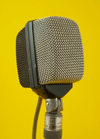 |
AKG D 12 |
A real classic, still popular for recording bass instruments, but originally intended for vocals and speech. This was the bassdrum mic of Abbey Road, used by the Beatles and many others. |
|
| |
|
|
|
|
| |
 |
Shure 51 |
Shure from 1948, in a wonderful 'Space Age' design. It can often be seen as vocal stage mike of Motown vocalists. |
|
| |
|
|
|
|
| |
 |
Astatic 7 C 40 |
Astatic crystal microphone, for CB radio and P.A.. |
|
| |
|
|
|
|
| |
 |
Grampian |
English microphone in a pre-war design. Until the mid 1950s, the influence of the Second World War was clearly visible in Euro-design: it had not developed since the Thirties, but was simply continued. This model was used for P.A. |
|
| |
|
|
|
|
| |
 |
Turner 200 |
Quality microphone, from the end of the Forties, for Radio and P.A. |
|
| |
|
|
|
|
| |
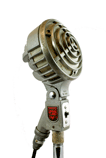 |
Philips EL 6030 |
Interesting large Philips dynamic; designed by the Electro Acoustic division of the company. It was produced for over ten years and used in studios and P.A. One of its famous users was Sarah Vaughan at a concert in the Concertgebouw in Amsterdam, in 1958.
|
|
| |
|
|
|
|
| |
 |
RCA BK 1 |
De RCA BK 1, from 1952, was the very first type with an axial design. Until then all microphones were side adressed, because the capsules were mounted on a side of the microphone housing. The dynamic 'Icecone' could be pointed at the sound source and an interviewer could stick it in someone's face for comment. It also became the Presidential microphone in the United States. |
|
| |
|
|
|
|
| |
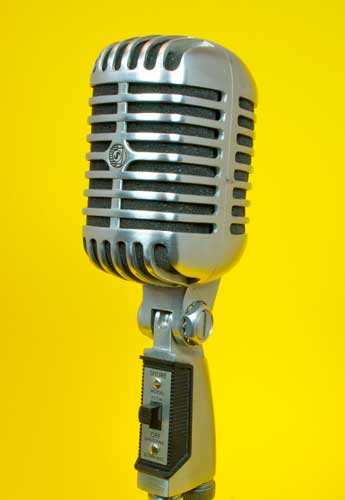 |
Shure 55 SH |
Successor of the 'Fat Elvis'. This smaller model would become the icon of Rock & Roll and can be seen in the movie 'Good Morning Vietnam' as D.J. microphone for Robin Williams.
With modernised innards, it is still in production. Shure claims: 'it is the most recognizable microphone in the World', which I think is true. |
|
| |
|
|
|
|
| |
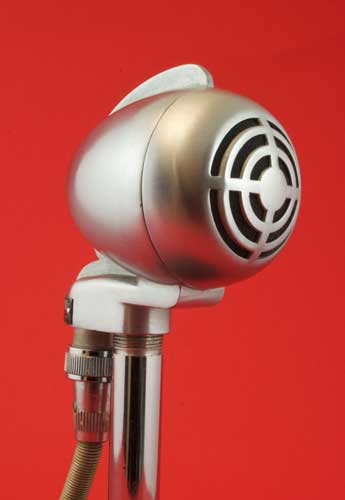 |
Turner Challenger |
Marvelous mic, for CB radio and paging. It was fitted with either a crystal or a dynamic element. |
|
| |
|
|
|
|
| |
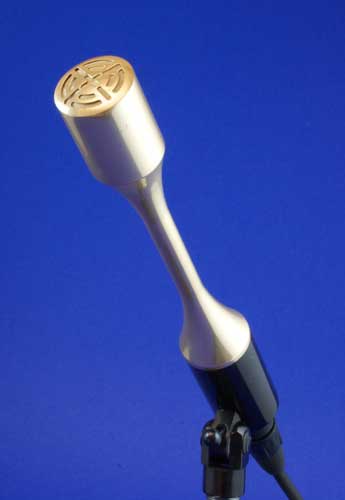 |
American D 22 |
Slim 'Full Vision' model, the shape did no longer hide the artist behind the microphone. Used for Radio, Television and P.A.. |
|
| |
|
|
|
|
| |
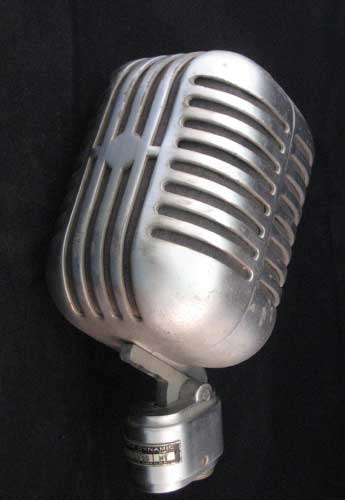 |
Turner 101 |
Turner 'Big Boy', with two capsules; a ribbon and a dynamic (like the Western Electric 639). It was meant for Radio and P.A.. |
|
| |
|
|
|
|
| |
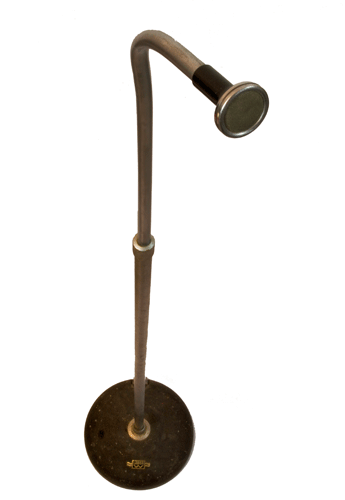 |
Labor W DM 3 |
The Labor W DM 3 was one of the first products of the (later rebranded as Sennheiser) firm. It is a dynamic, and adjustable in length to 1.6 metres. The actual capsule was hidden in the base of the microphone, the sound reached it through the long metal tube. It was also used in the U.S., for instance by Elvis Presley, for 'Hound Dog'. The DM 3 can also be seen on the cover of that record. |
|
| |
|
|
|
|
| |
 |
Astatic DR 10 |
The DR 10 'Synabar' crystal mic, a big mic by Astatic, for P.A., Radio and CB radio.. |
|
| |
|
|
|
|
| |
 |
Electro Voice 726 Cardyne |
This Electro Voice, from 1941, had to take on the competition of the Shure 55 S and shows a wonderful 'Space Age' design. It was designated for use in Radio, Film and P.A.. |
|
| |
|
|
|
|
| |
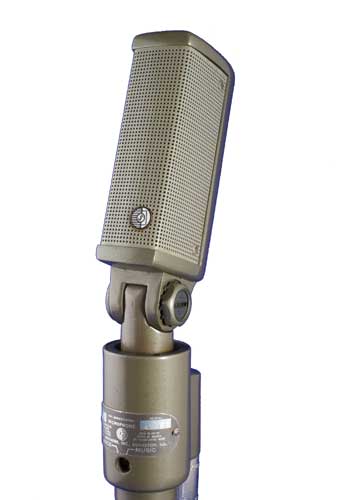 |
Shure 333 |
Shure's top of the line, the Uni(directional) R(ibb)on 'Concert line'. While other companies had been producing ribbon microphones since the Thirties, Shure entered that market not before 1952. It was a lot more expensive than the RCA's. A famous user was Marlene Dietrich.
This was also the 'Tonight Show microphone', America's best known talkshow host, Johnny Carson, had the 333 in front of him on his desk. In the early Eighties. 'The microphone that launched countless entertainment careers' was rescued from the trash heap and sold for $50.787,50, at an auction, where the audience applauded it for the last time. |
|
| |
|
|
|
|
| |
 |
Beyer M 26 |
A nice art-deco reporter mic by Beyer. Later the company was forced by Pharma giant Bayer, to change their name to Beyer Dynamic, to rule out confusion about the name. |
|
| |
|
|
|
|
| |
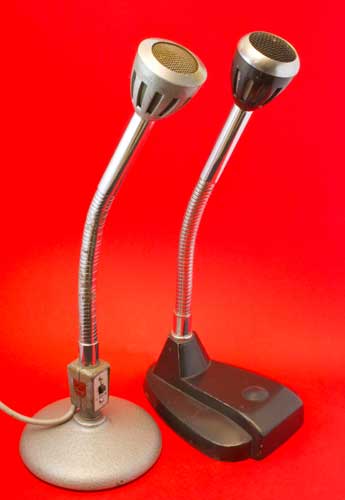 |
Philips EL 6031 |
The Philips EL 6031 'Tulip', left in the original style, produced between 1955 and 1960, and right the later version.They were made for P.A. and were used in the Dutch Parliament. Mick Jagger sang through it at Rolling Stones concerts, and can also be seen with it during a concert on British T.V. Fidel Castro used them for his exhausting speeches to Cuban audiences. |
|
| |
|
|
|
|
| |
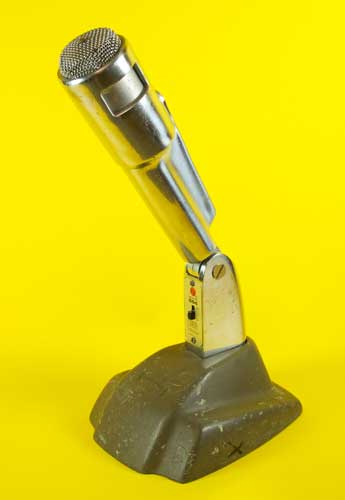 |
Electro Voice 664 |
Nice Fifties model by Electro Voice, with good sound quality. Marilyn Monroe sang for President John F Kennedy, through this mic, 'Happy Birthday, Mr. President', in Madison Square Gardens, New York. The 664 was Electro Voice's biggest commercial succes. ZZ Top uses them nowadays in live shows, but with modernized innards. |
|
| |
|
|
|
|
| |
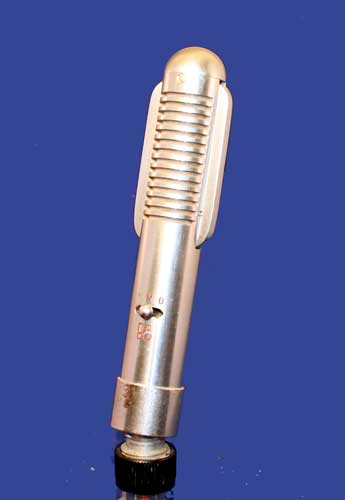 |
B&O BM 3 |
Original Danish design, a high quality ribbon type. It was used in the United Nations building, in New York. These days Royer, an American company, produces a number of models based on B&O designs. |
|
| |
|
|
|
|
| |
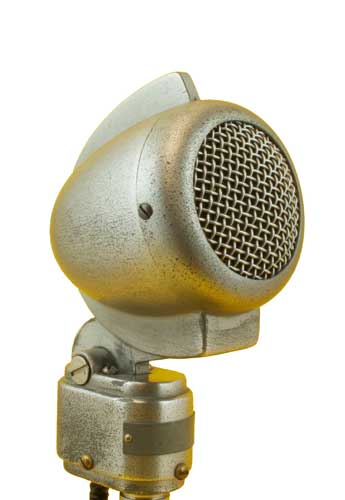 |
Turner 22 |
Another Turner in 'Space Age' design, made for P.A. and CB radio, it was alsosold badged as RCA. |
|
| |
|
|
|
|
| |
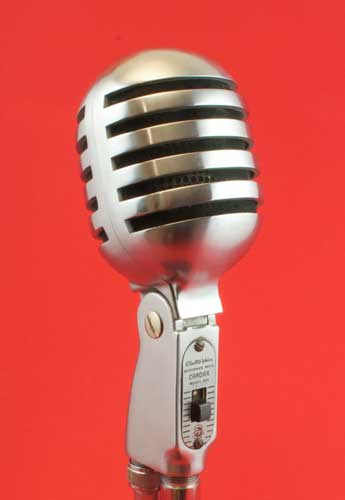 |
Electro Voice Cardax |
Beautiful crystal microphone by E.V., for CB radio, paging and P.A. |
|
| |
|
|
|
|
| |
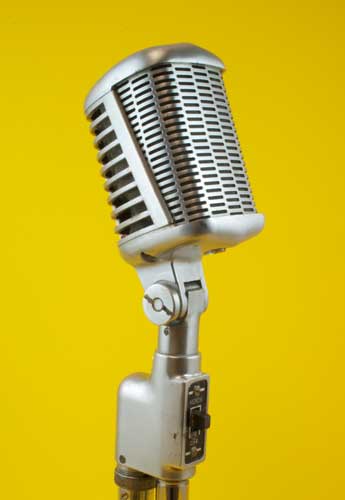 |
Astatic DR 77 |
The dynamic topmodel of Astatic, this one too was aimed to compete with the Shure 55SH. The DR 77 was often used by Bob Dylan, as vocal mic. |
|
| |
|
|
|
|
| |
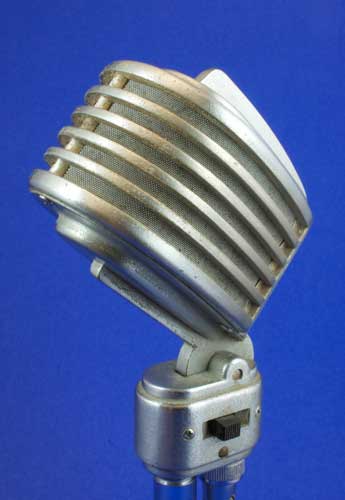 |
Turner 34 X |
One of the truly great shapes in microphone design, again by the Turner Company, that succeeded to produce an amazing number of wonderful and imaginative designs. Again a crystal mic for CB radio and paging. The Heil company makes an up to date copy of this wonderful classic. |
|
| |
|
|
|
|
| |
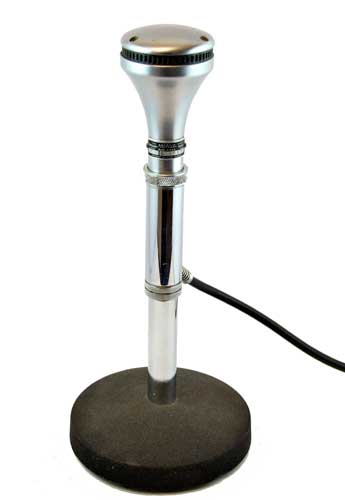 |
Astatic DK 1 |
This small UFO-like crystal has an uncommon design; the sound reaches the upwards facing element, through small holes around the top.
Small Astatic crystal mics are highly favoured by harmonica players, for their excellent tone. |
|
| |
|
|
|
|
| |
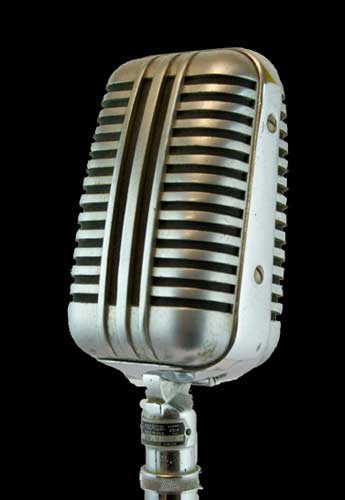 |
Astatic WR 20 |
Another luxury crystal microphone by Astatic. It contains two identical capsules (providing higher output) and was intended for P.A., Radio and C.B. |
|
| |
|
|
|
|
| |
|
|
|
|
| |
|
|
|
|





















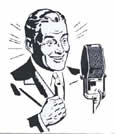
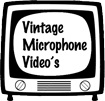 Video's
Video's Contact
Contact

































